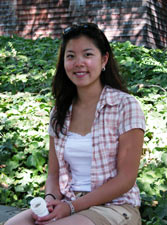Berkeleyan
Berkeley student selected for new 'green' intern program
![]()
| 16 September 2004
 Judi Quach. (Paul Reed photo) |
But this fall, her work also includes encouraging students to buy appliances with the Energy Star symbol, to use energy-efficient compact-fluorescent light bulbs, and to sign an energy pledge to reduce waste.
“I want to see the numbers at the end of this year reflect that there was a considerable reduction in energy use and increase in energy efficiency,” says Quach, a senior in Environmental Science, Policy and Management. “I want the students to know that their choices make a difference.”
Quach is breaking new ground this year as UC Berkeley’s first “green intern,” working to advise students on ways to conserve energy. She’s one of six California college students taking part in a pilot project funded by the ratepayers of California under the auspices of the Public Utilities Commission (PUC). In addition to Berkeley, interns are at UC Santa Barbara, UC San Diego, and the California State College campuses at Humboldt, Sonoma, and San Bernardino. The interns are paid $10 an hour for 20 hours of work a week and are employees of the alliance.
The Green Campus Program was developed by the Alliance to Save Energy out of the success of its Green Schools Program for K-12 schools. The Alliance to Save Energy, a Washington, D.C.-based nonprofit, worked with the California PUC to get a $1.5-million grant for the new two-year program, which began in June.
“The program is unique,” says Ryan Buckley, a recent Berkeley graduate who was a co-founder of the Chancellor’s Committee on Sustainabaility hereand now works as California program associate for the Alliance to Save Energy. “The interns have almost full autonomy, and we rely on their expertise to run a successful program. What we want to see is an energy use reduction on the campuses.”
Quach is taking a proactive role in educating her fellow students about identifying and reducing energy waste. For example, as a resident assistant, Quach is in a position to talk to new students about the impact their daily living decisions have on the environment. These include whether to buy a compact-fluorescent lamp (CFL) instead of a halogen or regular light bulb, turning off their computer monitors instead of using screensavers, and deciding what kind of small refrigerator to buy.
In these first few weeks of the fall semester, Quach says, she’s been setting up competitions between halls to see which is the most energy-efficient. And while the victorious residence hall may be awarded a pizza party or a foosball table as a prize, Quach is more interested in changing students’ habits over the long term.
“Students should take these ideals and practices with them when they move out,” Quach says. “That’s the big goal: creating sustainable behavior.”
Quach and others will staff tables in front of the residence halls as part of Sustainability Week, which begins next Monday. Quach will give away energy-efficient compact-fluorescent light bulbs and ask students to sign an energy pledge to reduce waste.
In the future, she plans to set up a model residence-hall room showing students ways to cut back their energy use.

